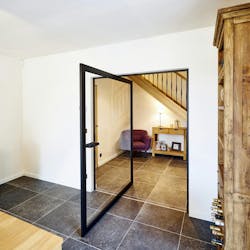Is a Pivot Door Right for Your Next Project?
You may have seen them more on houses in the last five years—a front door that rotates on a pivot box rather than on traditional side hinges. Ideal for large panels, pivoting doors exude a cool contemporary vibe, but whether they are right for your next home is another question.
“Pivot doors have become popular because they give a wide, generous opening and a simple, modern appearance that works well with contemporary architecture,” the Woodworkers Co. blog says.
Used mostly on high-end and custom homes, pivoting doors are benefiting from two converging trends in home building: houses with a greater indoor/outdoor connection and increasingly larger doors to facilitate that kind of lifestyle. The same trends popularized the folding and lift/slide patio door, and now the front door is next.
“A pivot door provides unique and beneficial features such as larger sizes than are typically available in traditional doors,” says Lance Premeau, Kolbe’s product and market manager. “The high-performance hardware allows for smooth operation of panels much wider and taller than a traditional door. The operating hardware itself can be adjusted in both traveling speed and closure speed. This enhances the user experience of opening and closing the door by dialing in the functionality of the door to the individual user or household.”
READ: What should you know about folding and sliding patio doors?
Pivot doors allow for streamlined, smooth operation
The doors offer many benefits. In addition to a seamless, streamlined look, they offer smooth operation. It “operates as a beautifully balanced panel that seems almost independent of its frame,” says Sue Weiland, of Weiland Sliding Doors. The door panels can be built much wider with overall square footage greater than a side-hinged door, she adds. Weiland offers pivots up to 9 feet wide and 13 feet tall.
One issue that comes with some pivoting doors is warping. “Unlike standard doors, pivot doors are not restrained by hinges down one side that stabilizes any tendency for the timber to move,” Woodworkers Co. writes. “Pivot doors swing on a point, top and bottom, that provides no restraint to warp movement in the door. Most doors remain stable in any event but as timber is a natural product (with stresses built into it from its life within the tree) it can assume any shape when unrestrained that can pull the fabric of a door into a warp.”
Woodworkers says that most times the warping is not easily detectable, but it still cautions clients and customers in advance that the large doors can naturally have larger bows and warps than conventional doors.
READ: Manufacturer Develops Economical, Prepackaged Pivot Door Kit
One of the biggest drawbacks to using a pivot door is cost—they're up to 30 percent more than a single door and sidelight combination and twice as expensive as a standard-width single door, by some estimates.
Expensive, but luxurious
“Pivot doors may be the most expensive designer doors but there’s no escaping the luxurious feel that they lend to designs by top architects who help to create the most leading-edge structure designs by featuring the best exterior doors,” door manufacturer Sing Core writes on its website.
Indeed, if your budget allows and you have the right house, the right product, and the right client, the pivot door might be one of the coolest things you can do to the entry of your home.
